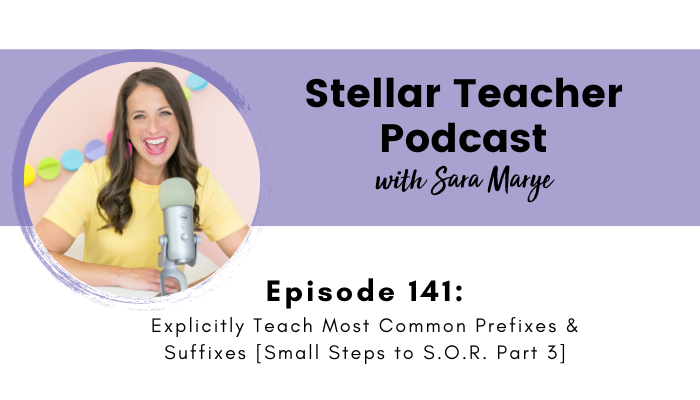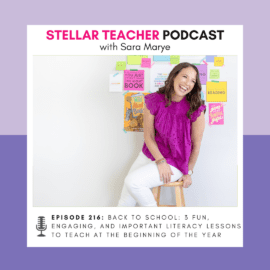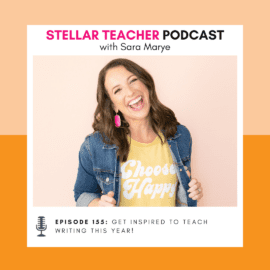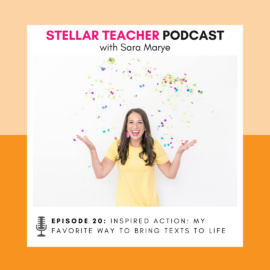
Click play below to hear how to explicitly teach common prefixes and suffixes:
By now you know that the science of reading relates heavily to Scarborough’s reading rope and its two strands are word recognition and language comprehension. Well this week’s step aligns with both strands in creating a skilled and confident reader, which is teaching common prefixes and suffixes. In the third episode of this series, I’m going to share why explicitly teaching common prefixes and suffixes helps your students with their reading skills.
Having a good understanding of common prefixes and suffixes impacts a students’ reading in such a positive way. I discuss what those benefits are and how it simultaneously helps their writing skills as well. Along with explicitly teaching the most common prefixes and suffixes, there are things to keep in mind regarding both affixes that enhance their literacy skills. Stay tuned next week for another small step to S.O.R.
In this episode on common prefixes and suffixes, I share:
- Ways prefixes and suffixes aligns to Scarborough’s rope
- The lesson structure to best teach these common affixes
- Things to keep in mind when teaching prefixes and suffixes
- How to master phonics and vocabulary with this teaching
Resources:
- Word Lists for Most Common Prefixes & Suffixes
- Sign up for my Private Podcast: Confident Writer Systems Series
- Check out the Stellar Literacy Collective Membership
- If you’re enjoying this podcast, please leave a review on Apple Podcasts!
Related episodes and blog posts:
- Episode 139, Practice Sentence Deconstruction [Small Steps to S.O.R. Part 2]
- Episode 137, Build and Activate Background Knowledge [Small Steps to S.O.R. Part 1]
- Episode 85, What is the Science of Reading & Why is it Important?
Connect with me:
- Join my newsletter
- Shop my TPT store here
- Instagram: @thestellarteachercompany
More About Stellar Teacher Podcast:
Welcome to the Stellar Teacher Podcast! We believe teaching literacy is a skill. It takes a lot of time, practice, and effort to be good at it. This podcast will show you how to level up your literacy instruction and make a massive impact with your students, all while having a little fun!
Your host, Sara Marye, is a literacy specialist passionate about helping elementary teachers around the world pass on their love of reading to their students. She has over a decade of experience working as a classroom teacher and school administrator. Sara has made it her mission to create high quality no-fluff resources and lesson ideas that are both meaningful and engaging for young readers.
Each week, Sara and her guests will share their knowledge, tips, and tricks so that you can feel confident in your ability to transform your students into life-long readers.
Tune in on your favorite podcast platform: Apple, Google, Amazon, Spotify, Stitcher, and more! If you’re loving this podcast, please rate, review, and follow!
Podcast (stellar-teacher-podcast): Play in new window | Download
This is our third week of our summer series, which I am calling Small Steps to SOR. Each Thursday I am releasing a bonus episode that gives you one small step that you can take to align your instruction to the science of reading.
Now, if you are just finding this podcast for the very first time, and this is your very first episode that you are ever listening to welcome, I am so glad that you are here. But I would encourage you to go back and listen to episode number 85, which is an episode I did last summer called, What is the science of reading? And why is it important?
And it’s a great place to start. And then you can find the first two episodes in our small steps series at episode number 137, where I talked all about how important it is to build and activate background knowledge anytime you’re reading aloud. And then in last week’s episode, which was number 139, we talked about how to practice a sentence deconstruction during reading.
So let’s jump in to today’s episode, which is your third small step. And that is to explicitly teach the most common prefixes and suffixes.
And before I get into that, let’s talk about how this aligns to the science of reading. And this small step can actually help you with a few aspects of the science of reading. And I’ve said this a bunch, so hopefully it’s starting to stick but we know that the end goal of our reading instruction is to help our students become skilled, confident and independent readers.
But in order to reach that end goal, students need to have skills in two main categories. And this is what is great about the science of reading because it really provides us a roadmap for what we need to be teaching our students. We know that students need to have word recognition skills, and that students need to have language comprehension skills.
And I’ve talked about Scarborough’s reading rope before. And I love this model because it gives us a great visual for understanding how the science of reading works. And so we want to imagine a rope and a rope is created by two strands that are twisted together. And in the reading rope, one strand is word recognition skills. And the other strand is language comprehension skills.
But within each of those strands, there are smaller strands that are woven together. and word recognition includes phonological awareness, phonics, sight word recognition, and language comprehension strand has the smaller strands of vocabulary, background knowledge, syntax and semantics, literacy knowledge and verbal reasoning.
And explicitly teaching the most common prefixes and suffixes can help with word recognition skills, because most prefixes and suffixes have predictable sound spelling patterns, which is going to help with phonics. And when we teach these prefixes and suffixes to our students, they have tools to help them decode and read multisyllabic words that include prefixes and suffixes.
But explicitly teaching the most common prefixes and suffixes can also help with language comprehension, specifically, vocabulary. Prefixes and suffixes also contain meaning. And when students learn the meaning of prefixes and suffixes, they have tools to understand the meaning of words that contain those prefixes and suffixes.
So students vocabulary is expanded as a result of focusing on prefixes and suffixes. So when you focus on this one small step, you can get a pretty big return.
Now, you’ll notice in my small step, I said explicitly teach the most common prefixes and suffixes. And I would suggest at a minimum, teaching the 10 most common prefixes and the 10 most common suffixes. And it’s important to keep in mind that there is way more than 10 prefixes and way more than 10 suffixes.
But the frequency in which they show up in text is pretty low once we get past the first 10, and a specially past the first 20. So if you leverage your instruction to focus on the most common prefixes and the most common suffixes, we are going to be much more effective than if we tried to teach every single prefix or suffix to your students that they will encounter.
You just do not have the time in your instructional year to teach every single prefix. But for example, let’s talk about just the frequency in which we see some of these common prefixes. The prefix UN accounts for 26% of total words with prefixes and the prefix RE accounts for 14%. Those are the two most common prefixes.
In fact, if you teach the 10 most common prefixes, so prefixes, number one through 10, your students should be able to recognize almost 80% of all words with prefixes, which is really good, I think.
And the same is true with suffixes. The most common suffix is S and ES. And this group of suffixes accounts for 31% of words with suffixes. And the second most common suffix is ED. And this one accounts for 20% of words with suffixes. And so if you teach the 10, most common suffixes, then your students are going to be able to recognize almost 85% of words with the suffixes.
So we can be really strategic with our instruction. And rather than just teaching random prefixes and suffixes, we can teach them the ones that they are most likely to see when they are reading. Now you’re probably wondering what are the most common prefixes and suffixes.
And I’ve put together a list for you, and you can grab that free download at stellarteacher.com/prefix. It does include both prefixes and suffixes. But I figured this link was easier for you to remember. So stellarteacher.com/prefix.
And I’m also including a sample of what one of our explicit prefix lessons looks like, you can always use that sample lesson to mirror your own lessons after, but I wanted to show you what it looks like in case you were interested in getting ready to print lessons for you.
These prefix and suffix lessons are part of the resource library that is inside the Stellar Literacy Collective. And we’re actually getting ready to open up doors for the 2023 2024 school year on July 10. So if you are interested in learning more about that, go to stellarteacher.com/waitlist.
Okay, so let’s talk about how do we actually teach these prefixes and suffixes. So when you’re teaching an explicit lesson on prefixes and suffixes, I like to use a pretty basic lesson structure. And this is the structure that we use inside our lesson plans.
So first, you want to introduce and explain, this means you’re going to introduce the prefix or the suffix, you’re going to give the definition of it, and maybe show an example of a word that has that specific affix, and really break that word apart.
So if you’re doing a lesson on the prefix on, you could use the word unhappy to explain what that prefix is. So you can tell your students something like we know that happy means having feelings of joy. And we know that the prefix un means not or opposite of. So we know that unhappy means having no feelings of joy, or feeling the opposite of happy, which is sad.
So giving them an explanation of how that prefix helps us understand the meaning of words. Then you can spend some time really teaching and modeling. And in this section, this is where you can give students additional examples. So they really have a strong understanding of that specific prefix.
I usually like to give three additional words that focus on the specific prefix or suffix and break down the words to define the base and the prefix of the new word and then provide it in a sentence. So students see the word, they understand the meaning of it, and then they see it used in context.
Then we move into guided practice for the lesson. And there’s a variety of things that you could do with your students. But ultimately, I like to have students do a couple of different things.
So you could have them read sentences that include words with the focus prefix and have them discuss what those words mean, you could have them build words with a prefix. So they understand that not every prefix can be added to every single word. And you could have them sort words with that prefix on it. So guided practice is where students get to actually practice a little bit.
And then you can give your students some sort of independent practice. And I think anytime that you are doing practice with word study concepts, it’s nice to give students opportunities to practice manipulating and exploring the words with that specific prefix or suffix.
So I like to give them the ability to play around with words, maybe they’re going to break words apart or make new words. But then I also want them to read those words in a sentence. And I want them to read those words in a paragraph. Because we don’t just want students to understand prefixes and suffixes at the word level.
We want them to understand that when they see these words in context, understanding the prefix is going to help with the meaning, which is going to help them understand the sentences that they read, and the paragraphs that they read. So word study practice should always be taken to the sentence level and the paragraph level.
So that is a pretty easy, basic lesson structure that you can use for your word study lessons when you’re introducing prefixes and suffixes. But in addition, there are a couple really specific things that are important to keep in mind when you are introducing the most common prefixes and suffixes to your students.
So with prefixes, there’s really three extra things that you want to mention during your lessons. And the first one is to make sure that you are teaching multiple meanings of the prefix if they exist. So many prefixes have more than one meaning, and we want to make sure that students know all possible meanings for words.
So for example, the prefix un means not. But it also means opposite of and while those are similar meanings, they are different enough that we want students to understand both of them. The prefix inter inter means between, but it also means among so we want to make sure that students know all possible meanings.
Another thing we want to teach our students is to pay attention for lookalike prefixes or imposters is another way to call it. For example, UN in uncle is not a prefix. So even though that word begins with the letters U N, they don’t function as a prefix, like they do in the word untie.
Same is true and the word pretzel P R E in pretzel is not a prefix. So even though that word begins with the letters p r e, they don’t operate like they do in the word preview. And we want to make sure that students understand that a prefix has to have the spelling, but it also has to have the meaning.
Because we don’t want students to get in the habit of just looking for the letters at the beginning of the word and assuming that those letters always have the meaning of the prefix. So teach them to pay attention for lookalikes or prefix imposters.
And then we want to teach students to use word parts plus context to understand the meaning. And this is important because like I mentioned, we don’t want students just to rely on looking for the word parts. But we also want to make sure that they’re understanding the context of the word.
And because prefixes can have multiple meanings, and because words can have imposter prefixes, it’s important that we always teach our students to rely on word parts and on context. We just don’t want our students to look for the letters U N, and assume that it always means not.
And we want our students to understand that having knowledge of prefixes is one tool, not the only tool, but it is one tool that they can use to read, write and figure out the meaning of unfamiliar words. So just reminding them that context is always important.
And when you’re teaching suffixes, there are really two extra things that you want to make sure your students understand. And the first is that there are two different types of suffixes. There are inflectional suffixes, and derivational suffixes. And this is something that is super important. And honestly, I did not focus on this enough when I was in the classroom.
In fact, I don’t even think that I fully understood the difference between these two when I was in the classroom. So I am thrilled that you all get to have this knowledge to impart to your students because it really does make a difference.
So inflectional suffixes are suffixes that do not change the part of speech of the word. For example, S, E S, Ed, and ing, are all examples of inflectional endings. If you add s to the word dog, you get dogs, and both dog and dogs are nouns, the part of speech did not change. If you add ing to laugh, you get laughing. both laugh and laughing are verbs. The part of speech did not change.
Derivational suffixes, on the other hand, are suffixes that do change the part of speech of the word. So for example, when you add the suffix l y to a word, it usually changes adjectives into adverbs. Calm is an adjective. When you add L Y get calmly, which is an adverb. When you add the suffix, N E S S to the word it usually changes adjectives, into nouns. Happy is an adjective. When you add NESS, you get happiness, which is a noun.
So understanding the different types of suffixes really helps students understand the meaning of the words, but it also really helps them understand the usage and when to use certain words with suffixes.
The second thing you want to make sure your students understand when you’re teaching suffixes is the spelling rules that are common with suffixes. Oftentimes, when we add a suffix to a word, it can change the spelling of the root or the base. So when you’re introducing suffixes to your students, be sure to also explain the spelling rules that go along with them when you add that specific suffix.
For example, if you’re going to add the suffix to a word that ends in y, you’re usually going to drop the Y and replace it with an I. This rule would apply when you’re adding the suffix nesss and ESS to the word happy. This rule would apply when you’re adding the suffix er to the word funny. To get funnier. This rule would apply when you are adding the suffix e s t to the word silly and getting silliest.
Another example is when students need to drop the E in order to add the suffix. So if a word ends with an E, we usually need to drop it before adding the suffix. We drop the E when we turn hope to hoping, we drop the E when we turn use into usable, and we drop the E when we turn drive into driver.
Having knowledge of the spelling rules is going to help students both with recognizing suffixes and the base or root words. But it also really helps them when correctly using the word with suffixes in their own writing so they know how to spell it.
So this is your small step for the week. explicitly teach the most common prefixes and suffixes and make sure that you are very thorough and your explanation of them as well. And don’t forget, if you want a list of the most common prefixes and suffixes, then you can go to stellarteacher.com/prefix to grab that list along with a free sample of our word study lessons.
And if you love the idea of having your word study lessons all planned and prepped for you this next year, then jump on the waitlist for the Stellar Literacy Collective doors open up for the 2023 2024 school year on July 10. And we would love to have you in that community. So be sure to tune in next Monday for our regular podcast episode, and come back next Thursday for another small step to the science of reading.








Leave a Comment
You must be logged in to post a comment.